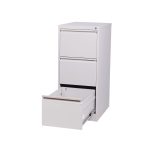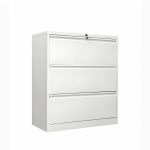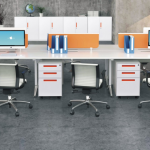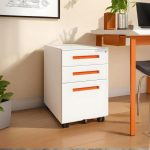When outfitting an office with storage solutions, the steel 3-drawer file cabinet represents the perfect balance between capacity and space efficiency. Unlike larger 4-drawer units that dominate room space or smaller 2-drawer options that offer limited storage, the 3-drawer cabinet provides optimal functionality for most office environments. However, prices can vary significantly—from under $100 to over $500.
Understanding what drives these price differences will help you make an informed decision that balances budget constraints with quality requirements. This guide breaks down all the factors affecting steel 3-drawer file cabinet pricing to ensure you get the best value for your specific needs.
Price Range Overview
Steel 3-drawer file cabinets occupy a moderate price segment in office furniture. Based on current market analysis, here's the general pricing landscape:
| Price Tier | Price Range | Typical Features | Best For |
|---|---|---|---|
| Budget | $100 - $200 | Basic construction, thinner steel (0.4-0.6mm), minimal security | Home offices, low-use environments |
| Mid-Range | $200 - $350 | Better construction (0.7-1.0mm steel), improved security, smoother slides | Small businesses, moderate use |
| Premium | $350 - $500+ | Heavy-duty construction (1.0mm+ steel), advanced security, premium finishes | High-security needs, heavy use |
Table: Steel 3-drawer file cabinet price tiers and typical features
Key Factors Affecting Steel 3-Drawer File Cabinet Prices
1. Material Quality and Thickness
The gauge of steel used significantly impacts both price and durability. Cabinets constructed with thicker steel (0.7mm to 1.2mm) typically command higher prices but offer greater longevity and resistance to denting. Budget options may use thinner steel (0.4mm to 0.6mm), which reduces cost but also reduces durability.
2. Security Features
The type of locking mechanism substantially affects price. Basic key locks represent the most affordable security option, while more sophisticated systems like electronic locks, combination locks, or advanced cam locks increase the price. Some premium models offer central locking systems that secure all drawers with a single mechanism.
3. Mobility Options
Cabinets equipped with quality casters or wheels typically cost more than stationary models. Premium mobility features include lockable wheels for stability when stationary and anti-tip mechanisms for safety when drawers are fully extended.
4. Drawer Suspension System
The quality of the drawer slide mechanism significantly affects price. Basic models may use simpler slide systems, while mid-range and premium cabinets typically feature ball-bearing slides that offer smoother operation and greater weight capacity. Full-extension slides that allow complete access to drawer contents typically command a premium.
5. Finish and Aesthetics
The surface treatment process affects both appearance and price. Basic painted finishes are most economical, while powder-coated finishes offer greater durability and scratch resistance at a higher price point. Custom color options from RAL or Pantone matching systems typically add 10-20% to the base price.
6. Brand Reputation and Certification
Established brands with quality certifications (like ISO9001 or ISO14001) typically command higher prices due to proven reliability and quality assurance processes. However, lesser-known brands may offer comparable quality at lower prices by reducing marketing overhead.
Detailed Price Breakdown by Feature
Understanding how each feature affects the final price helps in making value-based decisions:
Base Cabinet (no frills): $100-$150
- Basic 3-drawer construction with thinner steel (0.4-0.6mm)
- Minimal security features
- Standard finish colors
Mid-Tier Add-ons (per feature): +$25-$75 each
- Improved steel thickness (0.7-1.0mm): +$30-$50
- Enhanced locking mechanism: +$20-$60
- Better slide mechanisms: +$15-$40
- Mobility casters: +$25-$50
- Custom colors: +$20-$50
Premium Features: +$75-$150 each
- Heavy-duty construction (1.0mm+ steel): +$80-$120
- Advanced security systems: +$100-$150
- Commercial-grade slides and suspension: +$75-$100
- Specialized finishes or textures: +$75-$125
Where to Buy 3-Drawer File Cabinet: Price Comparison
Prices vary significantly across different retail channels:
E-commerce Marketplaces: (Alibaba)
- Price range: $100-$300
- Advantages: Direct manufacturer prices, bulk discounts available
- Considerations: Shipping costs may be significant for heavy items
Office Supply Retailers:
- Price range: $200-$400
- Advantages: Immediate availability, often include assembly
- Considerations: Higher markup for convenience
Specialized Furniture Retailers:
- Price range: $300-$500+
- Advantages: Expert advice, higher quality options
- Considerations: Premium pricing
Secondhand/Refurbished:
- Price range: $50-$150
- Advantages: Significant savings
- Considerations: Variable condition, limited selection
Bulk Purchase Discounts and Negotiation Tips
For business purchases requiring multiple units, volume discounts can substantially reduce per-unit costs. Dongzhixin Office Furniture offers tiered pricing:
- 5-10 units: 5-10% discount.
- 10-50 units: 10-20% discount.
- 50+ units: 20-30% discount (often negotiable).
Negotiation strategies:
- Request quotes from multiple suppliers.
- Ask about price matching.
- Inquire about floor models or slightly imperfect units.
- Consider ordering during promotional periods (typically January and July).
Hidden Costs to Consider
Beyond the sticker price, consider these additional expenses:
Shipping and Delivery: $50-$150+
- Large, heavy items often incur substantial shipping costs.
- White glove delivery (placement and setup) adds $75-$150.
Assembly: $50-$100+
- Professional assembly recommended for larger units.
- Some retailers include basic assembly.
Accessories: $10-$50+
- Additional hanging folders or dividers.
- Specialty organizers for non-file items.
Price vs. Value: Making the Right Investment
While initial cost is important, considering long-term value is crucial:
Budget Options ($100-$200):
- Pros: Low initial investment.
- Cons: May need replacement in 3-5 years, limited security.
- Best for: Light home office use or temporary needs.
Mid-Range Options ($200-$350):
- Pros: Good balance of cost and durability, better security features.
- Cons: Higher initial investment.
- Best for: Small businesses with moderate usage.
Premium Options ($350-$500+):
- Pros: Maximum durability and security, often backed by longer warranties.
- Cons: Significant initial investment.
- Best for: High-security environments or heavy daily use.
Conclusion: Finding the Right Balance
The most expensive option isn't always the best choice, but neither is the cheapest. Consider your specific needs for security, durability, and aesthetics, then select a cabinet that offers the best combination of features within your budget. Remember that a quality file cabinet is a long-term investment in organization and efficiency that should serve your needs for many years.





